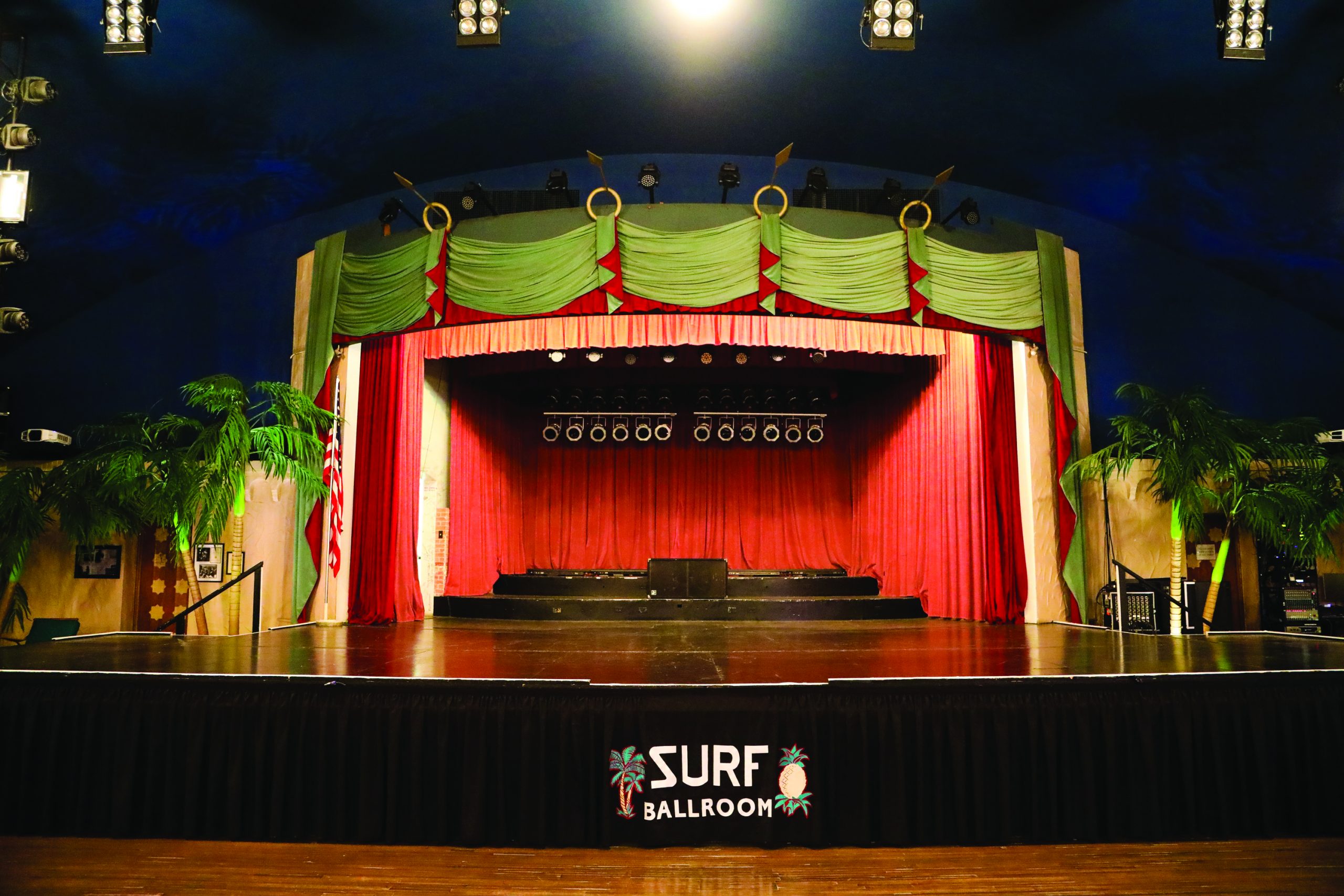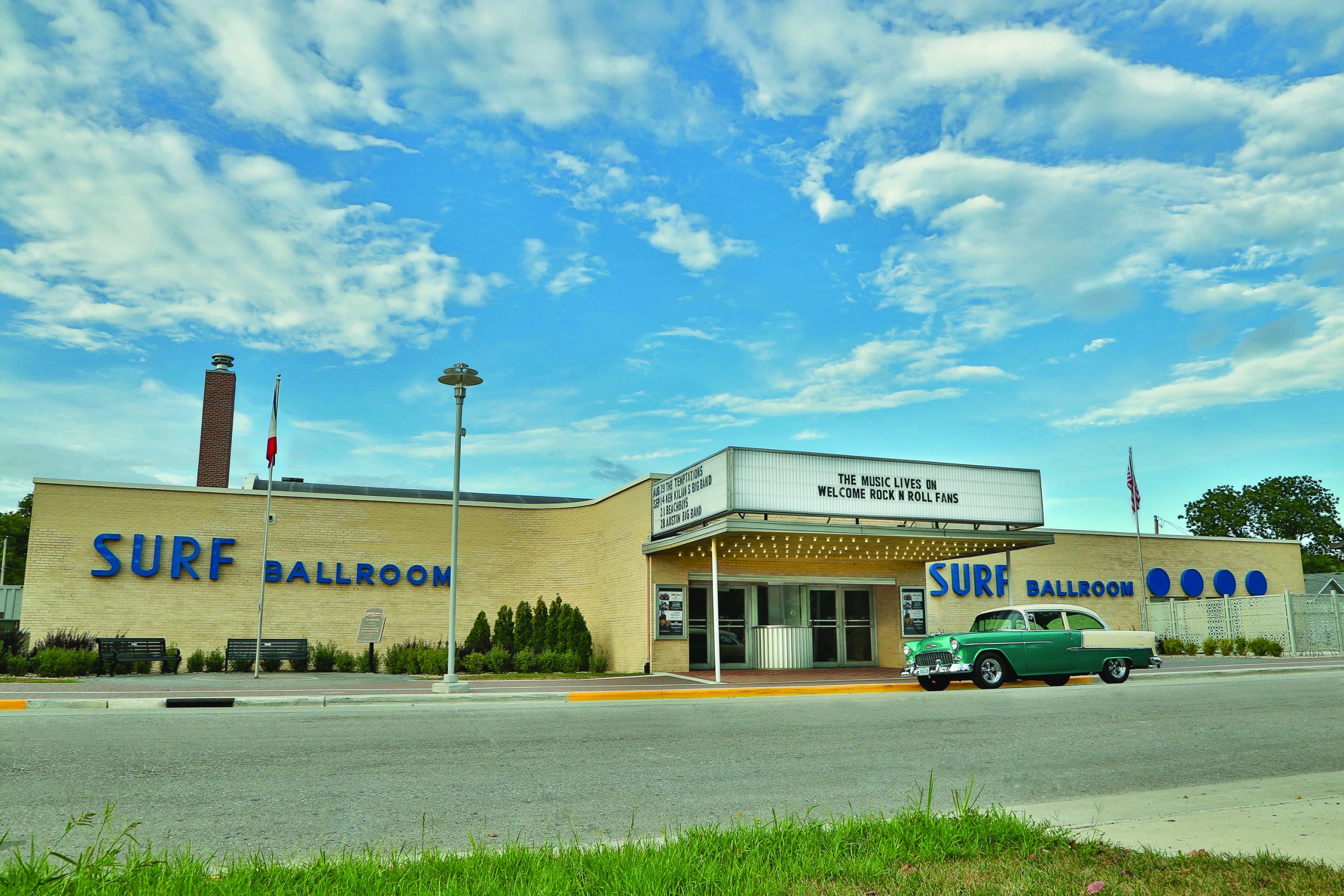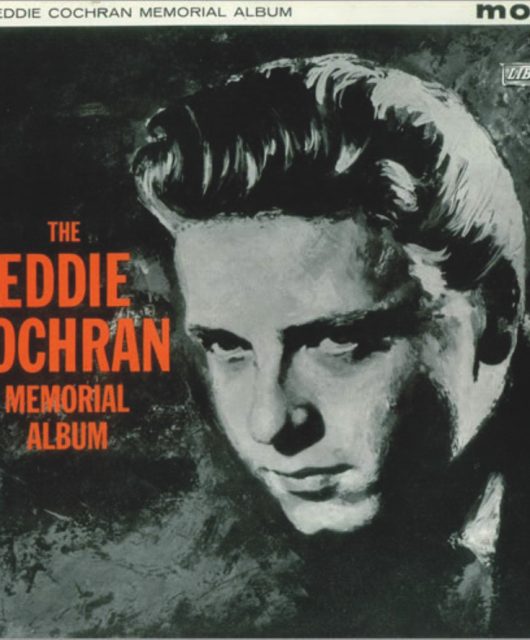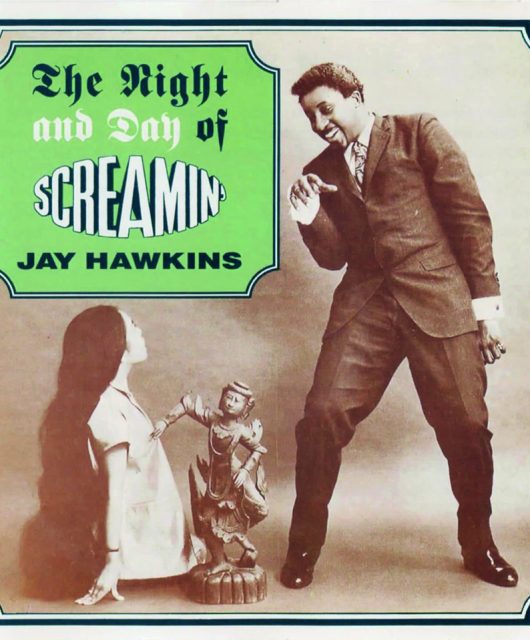Boasting both the Surf Ballroom and the Everly Brothers’ childhood home, Iowa is proud of its iconic landmarks. Music heritage scholars Sherry and Sheryl Davis tell Vintage Rock why they are dedicated to preserving rock’n’roll’s Midwest American presence…
Step onto the hardwood floors, surrounded by ocean-front murals and booths reminiscent of milkshakes and rock’n’roll. Look up into the clouds floating on the ceiling and realise that the sky is still the limit. You are indeed standing on the stage of American music.” So states the website of the hallowed Surf Ballroom.
For 50s music fans, the Surf Ballroom, in Clear Lake, Iowa, is legendary. It was here, of course, in February 1959 that the final career performances of Buddy Holly, Ritchie Valens and J.P. ‘The Big Bopper’ Richardson took place at the fateful Winter Dance Party. Hours later, all three died shortly after takeoff in an plane crash nearby.
The Tribute To Buddy Holly Concert 20 years later on 3 February 1979 evolved into a two-day event in 1980, and by 1992 it had officially become a weekend-long celebration of 50s and 60s music held across multiple locations in the Clear Lake community.
Thousands of fans flock to Iowa to pay tribute to their music idols, jive to the likes of That’ll Be The Day, La Bamba and Chantilly Lace, and have a great time in the style of 1959. It’s become known as marking the day the music didn’t die, as fans strive to keep it very much alive. In the same spirit, professional preservationists, twin sisters Sherry and Sheryl Davis, got involved.
Regarding the continued nostalgia for the ballroom and all it represents, Sherry considers: “Teenagers were central to the rock’n’roll movement as song subjects, audience members and first-time consumers who powered the record industry.
The cultural transition into the 1960s was as much about a symbolic loss of innocence as it was the loss of rock’n’roll in its original form. Clear Lake brings everything into perspective in such a profound way, that if any place embodied this moment, it would be the Surf Ballroom.”

The sisters’ original research, The Surf Speaks: Voices Of A Living History project, was dedicated to recording and preserving the Surf Ballroom’s ‘February Family’: the aforementioned worldwide community of rock’n’roll fans.
Earlier in 2021, the future of the ballroom was assured with its designation as a National Historic Landmark. This proved vital in the light of an abrupt halt being called to this year’s Winter Dance Party. With the local community typically earning more than
$1.5 million from the event, the venue’s finances were heavily dented by the pandemic. Happily, its new-found status should guarantee Federal funding and further support.
“Fandom subcultures and local communities are central to the continuing story of rock’n’roll. The idea of using these populations as leverage for preservation policy is a very new concept,” states Sheryl. “We believe it is a necessity to create a more democratic process in how we document, preserve and interpret the places that matter to us and tell our collective story. Eight of the 11 original Winter Dance Party ’59 tour sites headlined by Holly, Valens and Richardson still exist, and we’ve given serious thought to the idea of creating a heritage trail so that fans may follow in the footsteps of the tour leading up to the final stop in Clear Lake.”
In 2016, Sheryl became the interim museum director for the Iowa Rock and Roll Music Association and, in addition, the sisters both have research residencies in Cleveland at the Rock and Roll Hall of Fame library and archives.
So what kickstarted their musical adventure? “Our interest and passion for rock’n’roll began when we watched the film La Bamba,” says Sherry.
Watching a performance by Danny And The Juniors featuring original lead member Joe Terranova further inspired them to take guitar lessons to learn their favourite 50s hits.
“The music gave us so much joy that we wanted to share it with others and give life to the music in return,” Sherry continues.
Soon, their musical passion had expanded into the realms of historical preservation. Since 2017, the sisters have also been busy with heritage initiatives dedicated to the Everly Brothers’ life in Shenandoah. Don and Phil spent their formative years from 1945-53 in the city.
Their professional careers began as child stars on rival farmer-friendly stations KMA and KFNF during radio’s golden age. Their childhood home, a humble 15’x20’ clapboard cottage, was saved by The Everly Brothers Childhood Home Foundation. It’s the only house museum dedicated to the world-renowned sibling duo.

“Rock’n’roll of the 50s and early 60s represented a uniquely American moment in music history, where the fusion of black and white styles dominated the scene. The Everly Brothers were pioneers of this sound,” the sisters agree. “As many genres of roots music converged to form rock’n’roll, the Everlys led the way in contributing the tradition of country music and family-focused close harmonies, cultivated in Shenandoah.”
The Surf Ballroom almost became a Red Owl grocery store in the 1990s, and the Everly’s home was similarly saved from demolition in 2005. Relocated to the grounds of the Greater Shenandoah Historical Society in 2006, and dedicated in 2010, the site has now attracted scores of international Everly fans.
Amongst the prestige artefacts on display are a signed Everly Brothers 1963 Gibson J-180 guitar (pictured below), and a rare 10″ acetate of the demo for their Billboard No.2 hit, Problems. Each September, during Shenandoah’s annual Shenfest music festival, the Everly home hosts celebrations in tribute to the grand parade weekend, when the brothers reunited for the first of their homecoming concerts on 5 July 1986.
Attended by an audience of 8,000, it was organised by Bill Hillman, who later created the Everly Brothers Foundation, and also owns the Depot: an EB landmark where Bill hosted Don and Phil during their historic homecoming. The 100-year-old train depot, now a restaurant and listening room, houses what is arguably the largest public display of EB memorabilia in the world.
The Shenfest 2017 theme was ‘Walk Right Back’ to represent the Everly Brothers Childhood Home, the late Phil Everly’s class reunion and the recent completion of the plaque replacement project for the Iowa Walk of Fame in downtown Shenandoah. It also marked the 60th anniversary of the Everlys’ breakout single Bye Bye Love.
As part of a collaboration, Sherry and Sheryl made a mini-film, The Everly Brothers’ Musical Beginnings In Shenandoah, which they consider a “good step towards a proper full-length documentary”.

In October 2017, the sisters attended the inaugural Johnny Cash Heritage Festival in Dyess, Arkansas.
“We were there to learn more about the restoration of the Johnny Cash Boyhood Home to inform our own work, and also to draw inspiration from the shared biographical and musical ties between Cash and the Everly Brothers,” explains Sherry.
The sisters are featured in the video for Rosanne Cash’s The Walking Wounded, a posthumous song co-write with her father.
The ‘Cash experience’ influenced the establishment of Everly Heritage Day in June 2018 and the following year’s celebration grew into a two-day special. This incorporated an outdoor movie night, a ‘soda fountain social’ at the Brothers’ favourite George Jay drugstore, a panel of guest speakers, a performance by the Everly Brothers Experience and tours of the relocated KMA Radio, the station where Don and Phil debuted.
At the Surf Ballroom on 31 January 2019, the Everlys’ childhood home travelling exhibit also appeared on the 60th anniversary of the original Winter Dance Party tour, alongside speakers such as classmates and friends, and a concert by The Everly Brothers Experience.

Much like Graceland and the Elvis tourist trail, the sisters will continue highlighting the area’s musical treasures.
“Our campaigns can amplify each other, and hopefully inspire other communities who want to discover, activate and share their own unique music history and related places,” they say. “Music tourism offers cultural, social and economic benefits for communities. We believe it can be a major component of economic recovery and revitalisation in the post-pandemic world.
“We do our best to give a voice to the voiceless, built and human. Between apathy and greed, historic places don’t always escape the wrecking ball or decay of time. People don’t always have their stories or artefacts preserved. But for the Surf Ballroom, the Cash and Everly homes, there’s a happy ending.”
For more details, visit Sherrydavis.org; Sheryldavis.org; surfballroom.com and the Everly Brothers Childhood Home on Facebook
Read more: Hi-Tide Recordings






